Spotlight on Genna Martin
Jan 15, 2015
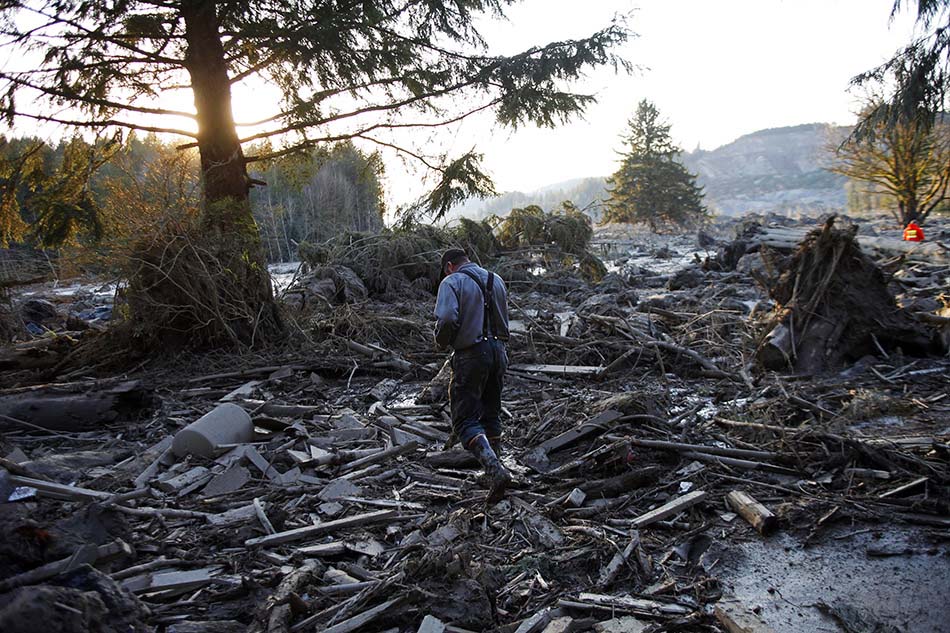
TID:
Thanks for your time, Genna. This image is so sad and part of something very tragic. Can you tell us a little about the event?
GENNA:
Thanks so much for asking me to be a part of TID. It's definitely an honor to be a part of something I value so much as a photographer.
On March 22, 2014 at 10:37 a.m. a major mudslide occurred along Highway 530 between the towns of Oso and Darrington in Snohomish County, Washington. The slide completely wiped out a square mile of land including the highway, river, and an entire neighborhood. Forty-three people were killed, most of whom were buried under mounds of mud and debris that were more than 70 feet high in places. Oso and Darrington are small, close-knit communities and the mudslide had a devastating effect on the area.
TID:
Since this is part of an ongoing news event coverage, can you tell us how you started at first, and what you went through mentally to prepare?
GENNA:
I'm a staff photographer at the Everett Daily Herald and we are the main paper for all of Snohomish County, which is just north of Seattle. I was home Saturday morning when the slide happened and got a call from my editor around noon to head up and check out what was going on. We already had one photographer who was in the area and arrived just after it happened. She was photographing people who were gathered at the local Oso fire station waiting for news. Landslides are not uncommon in our wet, muddy area of the country, and at the time we had no idea of incredible scale of the damage. I drove up to the area and found that local officials had already set up some roadblocks preventing cars from getting close to the area where the slide had wiped out the road. I managed to talk my way through the first roadblock and then parked and hiked about two miles up along the river to where the slide had happened.
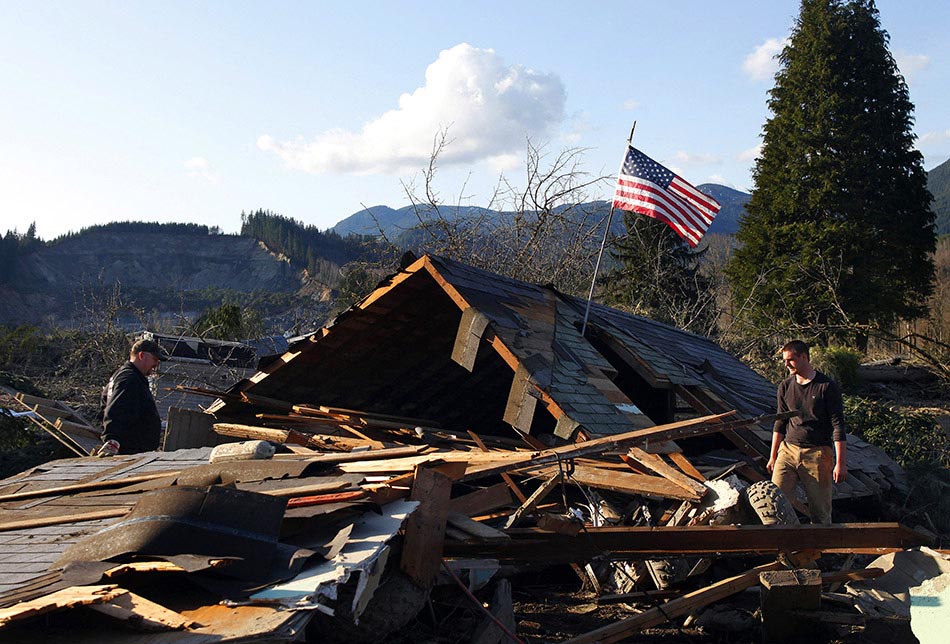
From my vantage point that first day, I could see damage, trees snapped like tooth pics, deep mud, the fragments of a house that blocked the highway, but I didn't get far enough really see the extent of it. Because the river was blocked upstream, many people thought it was going to blow through the debris and flash flood the area, so I was called back for safety reasons. We didn't really comprehend the size of the slide until seeing aerial photos the following day from Seattle Times photographer Marcus Yam.
Sunday, still low on information, I drove to Darrington, taking a two-hour detour because the highway, the main lifeline to the town, had been destroyed. It was from here that I was able to make my way down to the slide area and photograph the extent of the damage and recovery operations that were going on. I ended up spending most of the next two weeks in Darrington, photographing the aftermath and its effect on the community there.
TID:
What challenges did you encounter while working to making these images, especially at the beginning?
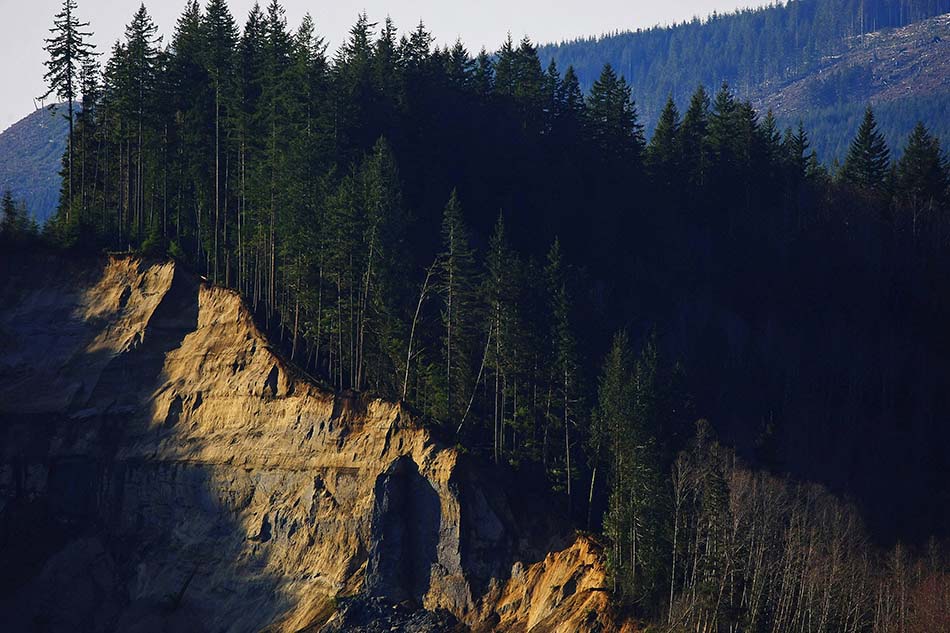
GENNA:
At the beginning, lack of information was a problem. No one really knew what was going on so we were kind of flying blind for the first few days. I really had to rely on instincts and gut feelings. I think many people who do this job, myself included, are "better to ask forgiveness than permission" kind of people, which can be useful when trying to shoot and get access to a chaotic situation like this. Once the myriad of agencies that respond to disasters and the national media descended on the area, a slew of new problems arose. Access being a main one. There was only one road leading in and out of the slide area and roadblocks were put up almost immediately on both sides.
Over the next few weeks, there was a carousel of different public information officers who were sent in to "deal with us" for a few days before returning their their regular jobs. Local and federal agencies on either side of the slide area were not communicating much and the policies on media changed daily, sometimes hourly. It was a very tough working environment and definitely a crash course on navigating bureaucracy. Another issue, was trying to tell the story while continuing to be as respectful as possible to the local communities. Luckily, the community of photojournalists I work with both at my paper and in the greater Seattle area are an amazing group of people who approach their work and subjects with the utmost solemnity and respect. I wish I could say that off all the media outlets who were there. And when a media circus descends upon a tiny logging town in the middle of nowhere, it's bound to create conflict.
TID:
How did you handle and overcome these problems?
GENNA:
When I first arrived in Darrington on Sunday, I knew I had to get into the slide area to show the damage. I got there in the late afternoon just as some of the fire and police crews were leaving the area and was able to get through another road block. Being the local paper and having strong connections within the town was incredibly helpful in getting access in those first days. I ran into a local guy who I knew from covering his daughter's high school basketball team (he was the coach), he remembered me and gave me a ride down a back road, through his friend's property into the slide zone. That was huge. He was able to vouch for me with the people I was photographing. If I hadn't have had those personal connections, I don't know if I would have been able to make those photos.
After that first day in Darrington, it just became a routine of pushing back against agencies to gain more access and when that didn't work, finding new and different ways to cover the story on a more personal level. There was definitely an initial backlash against the media from a hurting and protective community; which is completely understandable. We were there invading their space in a time of great pain, but after a few weeks of consistent, respectful and compassionate coverage most of the locals were able to see our presence was important. A huge outpouring of donations came in from all over the world to this tiny town. I think eventually the community realized that wouldn't have happened if we were not there.
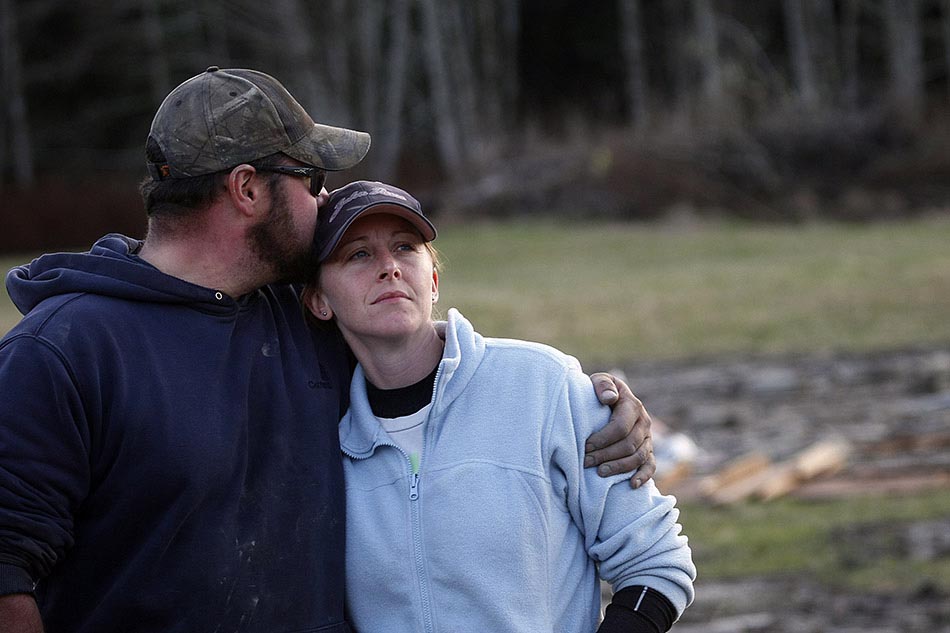
TID:
What has surprised you about your work during this trying time?
GENNA:
I had never covered tragedy of this magnitude or really anything like this event before. Every day was a learning experience. I was surprised by the connection I felt to the community. As journalists and I think especially photographers we keep ourselves distanced from our subjects, we are observers.
We see sad things all the time and then can do our work and go home and not really think about it too hard later. Maybe it was knowing the people directly affected, or spending so long in the community, but this stuck with me more than anything else I've ever covered has.
TID:
Now, onto the moment. Can you tell us specifically what was going on both here and in your mind leading up to the picture?
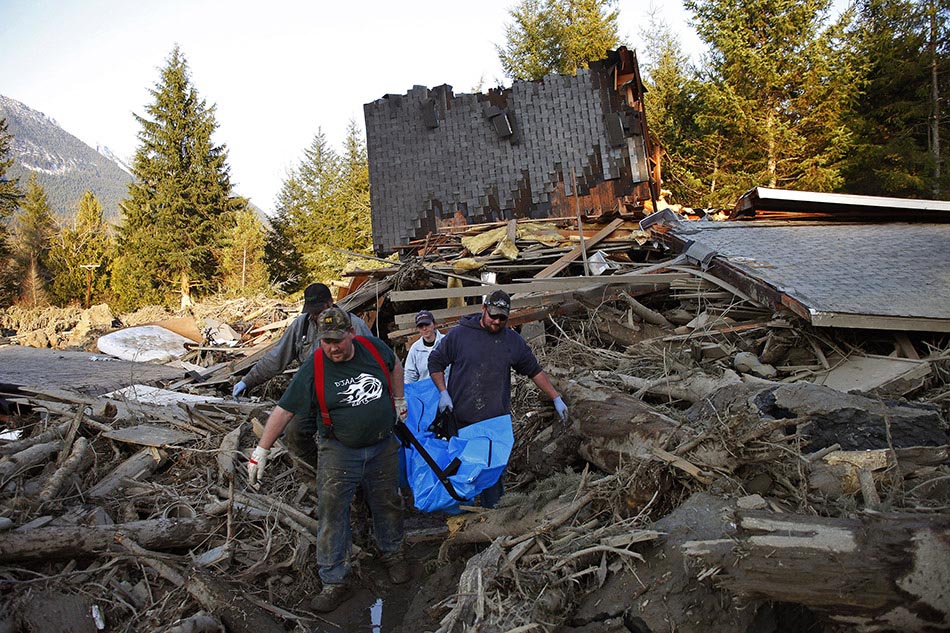
GENNA:
Once I arrived down on the debris field, it was mental and visual chaos. There was just so much. Where there had been a neighborhood there was now just mud and water and debris as far as I could see. I had never seen anything like it before. Everything was coated with grey mud and eerily quiet. I didn't know what to shoot first. Everything? I did that panicked running around shooting any and everything I saw thing for a few minutes before I was able to give myself a little "calm down and get focused" pep talk (at the time I still was worried I would be kicked out of the area at any moment). Then I was able to actually start thinking more clearly about the photos I was making. We had seen the aerials, but at that time no other photographer had been into the slide area yet. I remember standing on what used to be a house, looking out at everything and having that mental moment where I where I was like "no one has seen this yet, people need to see this."
I was at the southeastern edge of the slide field where most of the debris had been pushed. There was a family whose house had been destroyed and small group of friends and neighbors from the area gathered there looking through rubble for survivors, bodies, personal items. At this point they were still holding out hope that they could find people alive. They found three or four bodies while I was with them, most of which were not completely intact. I watched as they loaded bodies of their neighbors into body bags and silently carried them out to a field where a search and rescue helicopter could take them out of the area.
Although they didn't talk to me all that much, no one seemed to have a problem with me being there or photographing the scene. This photo was from that time, when I was following the group in and out of a grove of trees where most of the bodies were, jumping from one pile of debris to another as to not step in the quicksand-like mud that was near-impossible to free yourself from. I tried very hard to shoot with patience and restraint, but to keep shooting. Most of the people searching had been there since very early in the morning. None of them were official search and rescue personnel. The man in the photo is a logger who grew up on the hillside that was directly across the valley from the hillside that collapsed. The hill is named for his family.
I think this photo represents both the immense destruction of the slide and the immense resilience shown by the people of Darrington, Oso and nearby Arlington. Much of the recovery work was done by local people who refused to quit until the final missing body was recovered, four months after the slide.
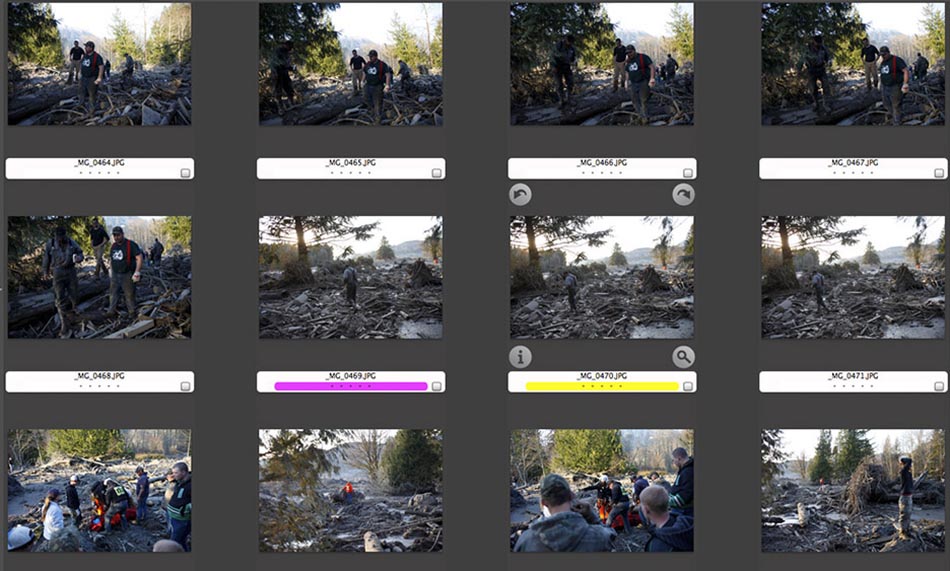
TID:
What have you learned about yourself in the process of making these images?
GENNA:
I learned how much I could be affected emotionally by my job. It was definitely the worst and most important thing I've ever had to photograph. In the moment, my camera and adrenaline were enough of a buffer between me and the scene and I was able to just buckle down and do my job. I'm not a very emotional person but, over the next few weeks, the toll of what I had seen became apparent. For months, the scenes of people pulling the bodies out of the debris would replay in my head when I would try to sleep. I would become emotional when talking or thinking about the slide. It felt wrong, like I shouldn't be having those feelings because nothing bad happened to me.
I learned I could and should rely on my colleagues to be there when I needed to talk things out. Everyone at the paper was excellent about making sure those of us who were down there in the muck, covering this tragedy day after day, were supported emotionally. Having this many feelings about a story was very foreign to me and I didn't really know how to handle it at first. Because this story went on for months, I obviously needed to take breaks, but every time I pulled away from the story, I just wanted to be back covering it. It was very hard to watch from the sidelines.
I also learned so much from my more experienced colleagues about how to be a compassionate journalist. How to interview someone who has just lost their mother and their four-month old baby and make sure you both still feel like humans afterwards. When it's ok to not take the photo. When the best thing you can do for someone is just listen to their story.
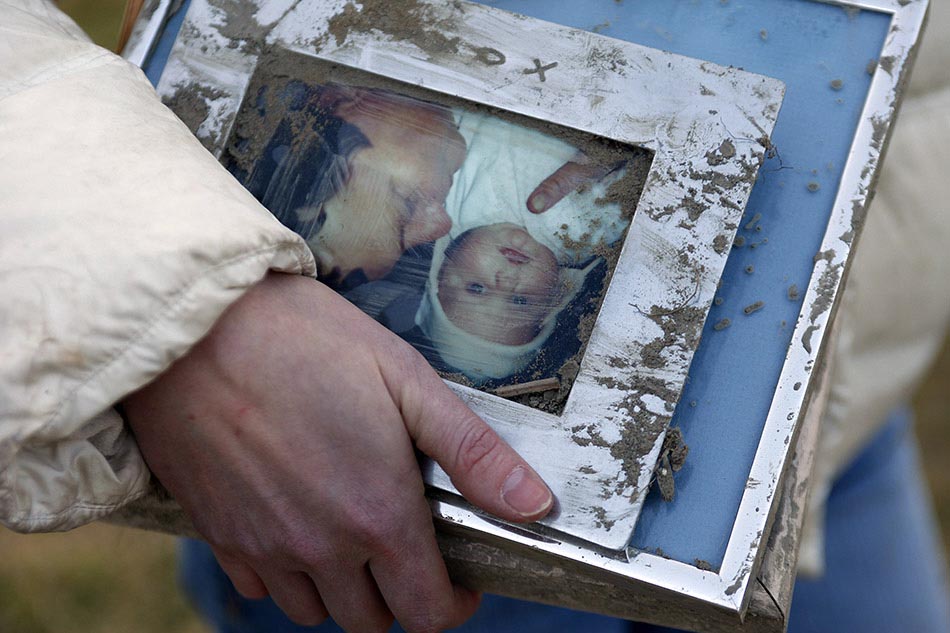
TID:
What have you learned about others?
GENNA:
I learned that people, especially these people, have an unbelievable capacity for resilience. I saw a community come together and rise up and do what needed to be done, no questions asked. They volunteered to cook meals for each other, rebuild the road, take people in who lost their homes, search day after day after day for their missing friends and neighbors. All with the utmost humility and strength. It was incredible.
TID:
In conclusion, what advice do you have for photographers?
GENNA:
Be a human first. See beyond your job and your camera to the people you are photographing. Always, but especially when covering tragedy. I know this is basic, but it can be easy to forget when you are focused on getting "the" photo. I found that compassion, respect and community connections opened more doors for me than anything else. It also meant that at the end of the day, I could go home and feel good about what I had done, and not feel like a vulture. If you're covering a tragedy like this, check in with yourself regularly. If you need a break, ask for it. Find someone to talk to. Feelings are ok. We aren't robots. Empathy will make you a better journalist.
Working alongside friends from Seattle's close-knit photo community was helpful also. There were about 5 or 6 other local photographers in Darrington with me during those first two weeks and it was great to have them there. Everyone was incredibly supportive and we could have a beer together and talk at the end of a long, emotional day. So, I would say be there for your fellow journalists. Even if you work for different outlets, you're all on the same team. Seattle's photojournalism community is an invaluable resource. Cultivate a community in your own town.

:::BIO:::
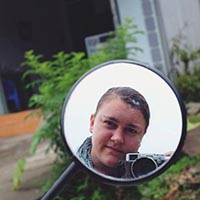
Genna Martin is part photographer, part Oregonian, and part bacon-lover. After graduating with a degree in photojournalism from Boston University in 2009, she worked for the Victoria Advocate newspaper in Victoria, Texas. She currently is a staff photographer at the Daily Herald in Everett, WA, where even on a bad day it's still better than your job. Genna loves getting to glimpse into other people's lives and learn something new every day. She can also be found exploring new places, playing water polo, or eating brunch.
You can see more of her work here: gennamartinphoto.com twitter: @photogenna IG: gmartphoto